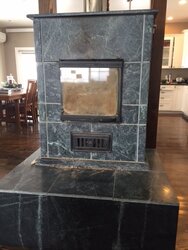Help
I have had this soapstone fire place for 3 winters now and I cannot figure out how to heat my house. I am loading it 3 times a day just to kind of heat the house. Loading it in the morning and at night is not enough. I loaded it again this morning and a couple of hours later, the house temperature is at 64. I know I am doing something wrong. Any help would be great! The only thing I do differently when burning is almost shut the bottom vent once the fire is going. The top nob on the upper right stays open and the nob below it slides in and out but I keep it in after I have lit my first few fires of the winter.

I have had this soapstone fire place for 3 winters now and I cannot figure out how to heat my house. I am loading it 3 times a day just to kind of heat the house. Loading it in the morning and at night is not enough. I loaded it again this morning and a couple of hours later, the house temperature is at 64. I know I am doing something wrong. Any help would be great! The only thing I do differently when burning is almost shut the bottom vent once the fire is going. The top nob on the upper right stays open and the nob below it slides in and out but I keep it in after I have lit my first few fires of the winter.



